- Compost, Fungus and Mushrooms, Gardening adventures, Hugelkultur, Permaculture and Edible Forest Gardening Adventures, Soil
More Spores: Planting Garden Giant and Shaggy Mane Mushrooms
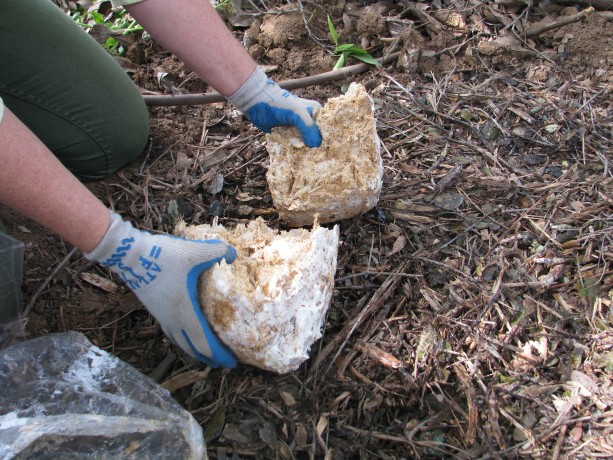
Breaking apart the large square of inoculated sawdust. The last scintillating post was about how we distributed oyster mushroom spawn in the straw in our new vegetable garden. Today we planted more shrooms… but not the last! “Where will it end?” you cry. I’m not sure myself; I guess it depends on how well we can grow mushrooms here in the drought-stricken west. It is the last week in February and we’ve had 70 degree – 90 degree daytime temperatures all month long, and less than a 1/2 inch of rain this year. This is our rainy season. Some mushrooms do grow here, although they aren’t very apparent this dry year. We certainly don’t have the high humidity, frequent rain and acidic loam that characterizes areas such as Northern California and the Pacific northwest where mushrooms are everywhere.
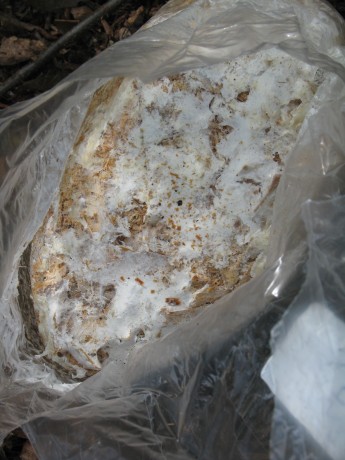
Shaggy Mane spores growing all over the bag. I bought two bags of spores, of Giant Mushroom and Shaggy Mane mushrooms, both of which are edible and can stand warmer climates, as long as they are shaded and receive water. My daughter and I strolled all over the property considering different spots. There aren’t a lot of areas which are shaded all day, which receive water or are close to water, and where shrooms would be safe from nibbling animals. We decided upon the small group of old lime trees (and one orange) that are between the fenced backyard and the Fowl Fortress.
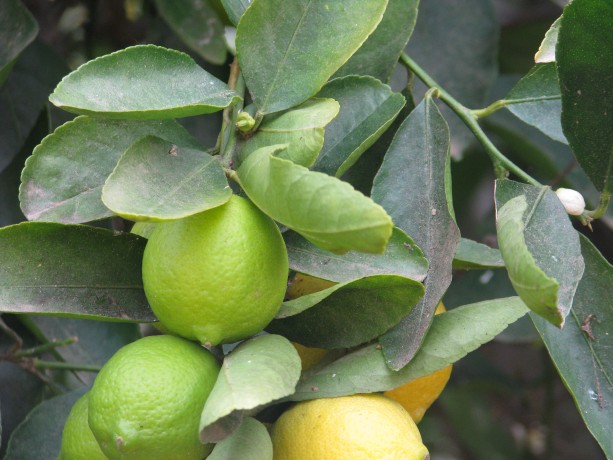
Limes look so very pretty, until they draw blood! I’m not a fan of lime trees. When I was 11, my parents moved me and my sister to a four-acre lime grove in Vista, CA. I grew up enjoying the smell of lime blossoms, walking through tens of thousands of bees (pre-Africanization), climbing up the few avocado trees and pretending I was a spy and bad guys were looking for me. But when I was older I was paid to care for the lime trees. I became disenchanted. They are nasty. Their thorns and small dead twigs scratch and catch, they are often full of ants which are harvesting aphids on the leaves, and they are short trees, so to pick limes or do anything for them you have to duck under the canopy and usually end up losing some hair and bleeding from the thorns.

A group of citrus trees, with logs cut for mushroom inoculation and some old chicken wire that is ready for a hugelkultur burial. So of course as an adult I moved onto property with a lot of lime trees on it. Limes aren’t very profitable, either. I keep the trees because I don’t water them yet they thrive, and I don’t believe in killing trees for no reason. Now their canopy can be put to good use.
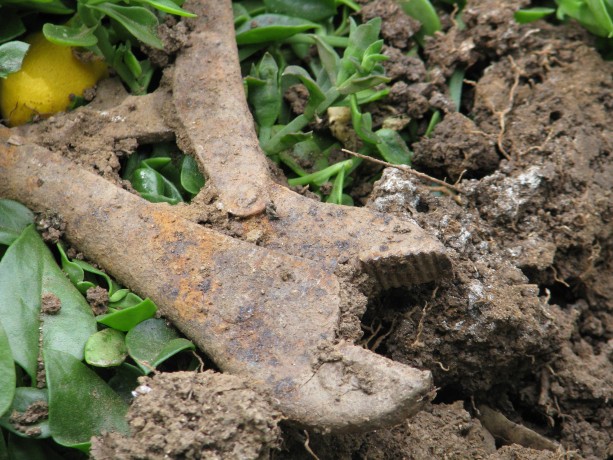
We always find some lost treasure from the previous property owner. I purchased organic mycelium from Paul Stamet’s Fungi Perfecti. He wrote many books on growing mushrooms and has had startling results using oyster mushrooms for soil remediation and with turkey tail and other mushrooms for fighting cancer and other illnesses. Mycelium Running is an incredible book.
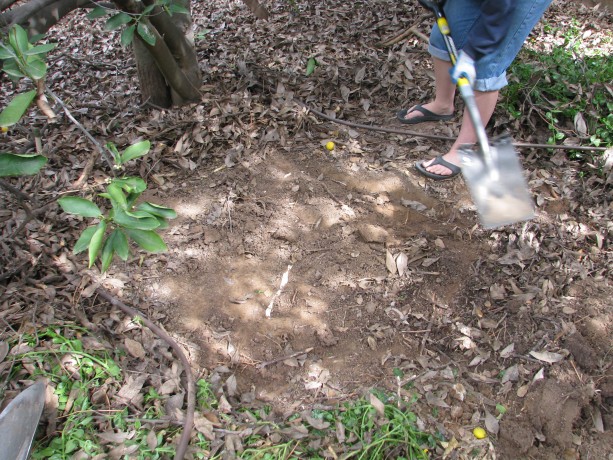
Clearing a level area under a lime tree. For the Garden Giant shrooms, we hacked through dead branches and pulled away a lot of red apple iceplant that has slowly been taking over from the neighbor’s property. We dug about two inches into the ground to help insulate the wood chips that would be placed in there, and watered it in well with what was left of the rain water from our large tank.
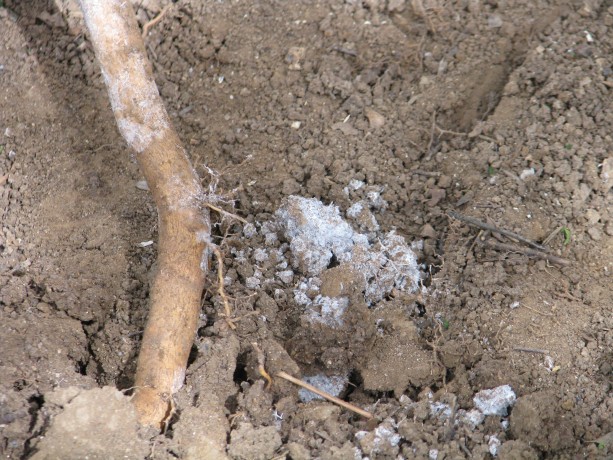
Mycelium is already busy around the roots of the lime and ash trees, even in this dry ground. We’d just received a truckload of chipped oak from landscapers, and that was perfect for this variety of mushroom. We spread out a couple of inches of chips, watered it well, spread the inoculated wood chips on top,

Spreading the mycelium… so many little spores! spread a couple more inches of chips over, mixed them up with our hands to spread the spores throughout the chips, and watered again. With luck, they should be up in a couple of weeks.
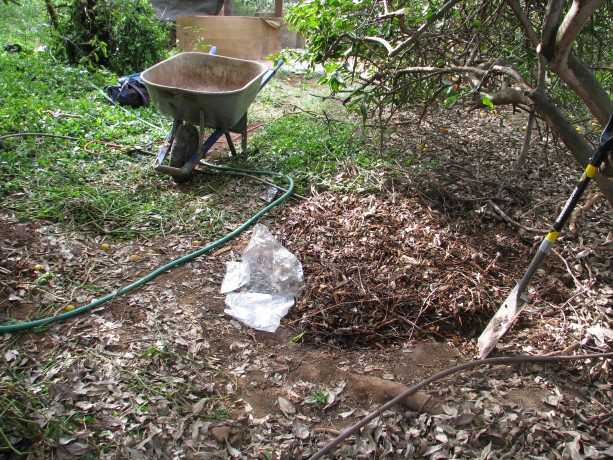
The final Garden Giant bed. Next to another tree we dug a 3×3 area just an inch down. Shaggy Mane lives in vegetative compost rather than the highly fungal wood chips, and can live in a variety of stuff.
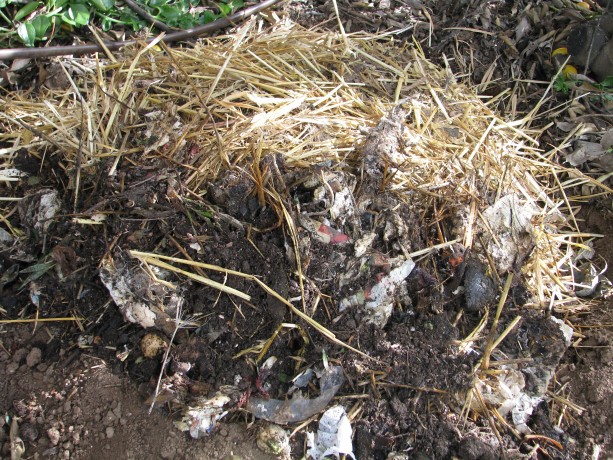
Vegetative compost mixed with straw and leaves for this long-term mushroom. We removed the more composted stuff from our cold compost bin and mixed it with very poopy straw from the chicken coop (thanks, girls!), and ash leaves. The spores were mixed well into this combination and watered in.

Mixing in Shaggy Mane spores with the compost. I topped it with leaves just to help keep the moisture in. We won’t see production from these until next winter when the temperature drops to below 60 degrees F. When they do ‘fruit’, as the mushrooms are called, we can add new compost alongside and the spores will creep over for another year’s growth.
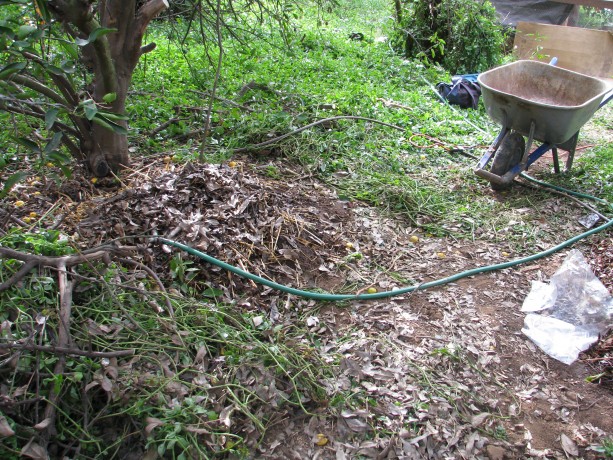
To assist with the moisture I’m going to have the greywater empty along these trees to keep the ground moist and the humidity up. Also, there are drip lines from the well along here and I think the addition of some above-ground sprayers will handle our watering needs without using domestic water.

The white tables are set under an orange tree, and are where inoculated logs will go. Under the orange tree, which is a fine tree but very neglected and hidden by the vicious lime trees, we decided to set up for our next installment of mushroom growing. We’ll be drilling holes in oak logs and growing four kinds of shrooms on them. I’m sure you just can’t wait!